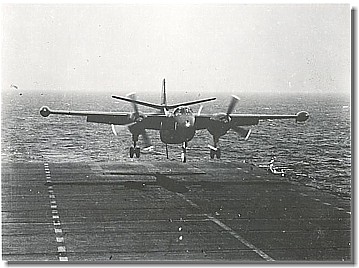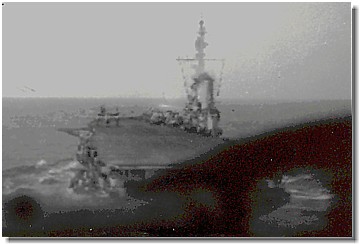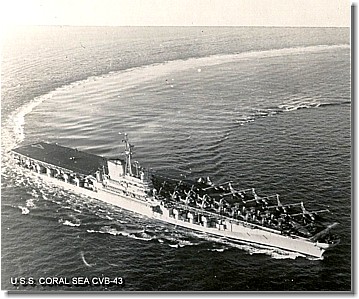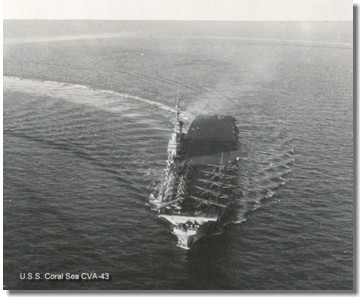|
This story is being taken from my recorded account of an important mission that Composite Squadron
Seven (VC-7) made in the Mediterranean while operating from the USS Coral Sea, CVB-43, the 5th and 6th of September,
1952…
In preparation for this heavy attack mission the Coral Sea sent her fighter squadron to the beach
to make room for the six heavy attack planes. After a long flight up from French Morocco, our squadron landed aboard
shortly after the fighter squadron departed.
We landed with the skipper, Capt McConnell, first of course and me last.
The Skipper's AJ-1 Savage from Heavy attack Squadron VC-7
doing carrier qualifications aboard USS Wasp CV-18 on
Feb 29, 1952

 |
As I was making my approach, I had my BN (Bombardier / Navigator) taking pictures. He had never ridden
aboard before in an AJ-1 and as we got closer to the ramp, he exclaimed, "Ya' got to be kidding; there isn't
room for all of us."
The photo below shows just how small an area was left for me to land on. Look closely at that last
plane ahead of me, which appears to still be in the arresting gear, with the other four planes parked ahead of
him.
U.S.S. Coral Sea recovering AJ-1 aircraft of VC-7 in the Mediterranean
Sea on 5 Sept1952.

 |
As soon as all planes were aboard, this huge ship made a 180 degree turn down wind as seen in the
photos below.
U.S.S. Coral Sea, CVB-43 in a turn following the recovery
of Six AJ-1 Heavy Attack aircraft of VC-7 on 25 Sept 1952.

 |
Another view of U.S.S. Coral Sea, CVB-43 in a turn following
recovery of aircraft of VC-7, 25 Sept 1952.

 |
This carrier and the heavy attack planes from VC-7 were to conduct an operation in which the planes
and crews from VC-7 were to be launched during the night to fly their simulated war time mission and then land
back aboard.
To get the proper distance from launch to target, it was planned that each would fly a dog-leg route
to the west end on the Mediterranean Sea and then on to a real target which would simulate their assigned war time
target. Every one was different.
I recall that we had something to eat and an early evening nap before "flight quarters"
were sounded and then the individual launches began some time after that. There was a respectable time and distance
between each aircraft.
I was launched last, of course, a short time before mid-night. Once again when I started my deck
run, my BN seated beside me expressed his opinion that this didn't seem to be a very smart thing to be doing. Most
of my mission was conducted on the 6th of Sept.
All six of our planes had similar but different routes to fly. To get the proper distance, I had
to fly west to a point near the Rock of Gibraltar, and then back to the north east over Majorca, at high altitude,
and on to Genoa, Italy, which I used as my simulated target.
After making a simulated attack on Genoa, we retraced our route at lower altitude and flew back for
a landing on our carrier with only fumes remaining in our fuel tanks.
I remember that the high altitude part from Majorca on, was over the back side and over the top of
a very active tropical weather front.
It was on that part of the flight that I experienced an extremely active attack of "St Elmo's
fire". My AJ-1 aircraft was simply on fire with visible static electricity running all over every edge of
the instrument panel. From the metal windshield supports, extending out into the Plexiglas. The flow of electrons
in the form of miniature lightning discharges put on an eerie show. The electrons being wiped off the propeller
blades also made a brilliant blue green circle or disk with the brightest part near the blade tips. The tips and
the trailing edge of the wings were also visible as a sheet of electrons as they were being wiped off the trailing
edge. This condition existed for over an hour. All I knew to do was just sit tight and climb a little higher. But
I elected to leave the radar and radios off.
During this time we were over-flying that front at an angle and were at or near 50,000 feet. We observed
lightning strikes or discharges shooting straight from the cloud tops and dissipating out into the same air mass
that we were flying in. Again we tried to ignore it and stayed right on course.
In all the rest of my flying days, I was never again to encounter a similar situation with the lightning
and static electricity cause by a condition that we call St Elmo's fire.
This story continues with some sad news we of VC-7 received when we returned to the Coral Sea at
the conclusion of these exercises. Follow the story Here.
- Hersch Pahl
[See Wikipedia definition for 'St. Elmo's Fire']
|